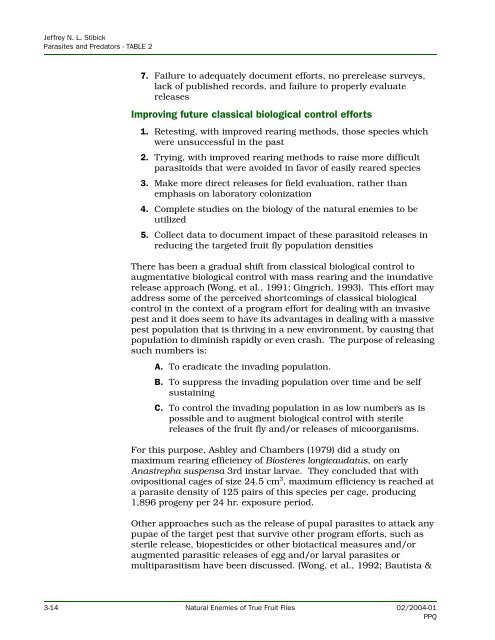Natural Enemies of True Fruit Flies (Tephritidae) - USDA - aphis
Natural Enemies of True Fruit Flies (Tephritidae) - USDA - aphis
Natural Enemies of True Fruit Flies (Tephritidae) - USDA - aphis
You also want an ePaper? Increase the reach of your titles
YUMPU automatically turns print PDFs into web optimized ePapers that Google loves.
Jeffrey N. L. Stibick<br />
Parasites and Predators - TABLE 2<br />
7. Failure to adequately document efforts, no prerelease surveys,<br />
lack <strong>of</strong> published records, and failure to properly evaluate<br />
releases<br />
Improving future classical biological control efforts<br />
1. Retesting, with improved rearing methods, those species which<br />
were unsuccessful in the past<br />
2. Trying, with improved rearing methods to raise more difficult<br />
parasitoids that were avoided in favor <strong>of</strong> easily reared species<br />
3. Make more direct releases for field evaluation, rather than<br />
emphasis on laboratory colonization<br />
4. Complete studies on the biology <strong>of</strong> the natural enemies to be<br />
utilized<br />
5. Collect data to document impact <strong>of</strong> these parasitoid releases in<br />
reducing the targeted fruit fly population densities<br />
There has been a gradual shift from classical biological control to<br />
augmentative biological control with mass rearing and the inundative<br />
release approach (Wong, et al., 1991; Gingrich, 1993). This effort may<br />
address some <strong>of</strong> the perceived shortcomings <strong>of</strong> classical biological<br />
control in the context <strong>of</strong> a program effort for dealing with an invasive<br />
pest and it does seem to have its advantages in dealing with a massive<br />
pest population that is thriving in a new environment, by causing that<br />
population to diminish rapidly or even crash. The purpose <strong>of</strong> releasing<br />
such numbers is:<br />
A. To eradicate the invading population.<br />
B. To suppress the invading population over time and be self<br />
sustaining<br />
C. To control the invading population in as low numbers as is<br />
possible and to augment biological control with sterile<br />
releases <strong>of</strong> the fruit fly and/or releases <strong>of</strong> micoorganisms.<br />
For this purpose, Ashley and Chambers (1979) did a study on<br />
maximum rearing efficiency <strong>of</strong> Biosteres longicaudatus, on early<br />
Anastrepha suspensa 3rd instar larvae. They concluded that with<br />
ovipositional cages <strong>of</strong> size 24.5 cm 3 , maximum efficiency is reached at<br />
a parasite density <strong>of</strong> 125 pairs <strong>of</strong> this species per cage, producing<br />
1,896 progeny per 24 hr. exposure period.<br />
Other approaches such as the release <strong>of</strong> pupal parasites to attack any<br />
pupae <strong>of</strong> the target pest that survive other program efforts, such as<br />
sterile release, biopesticides or other biotactical measures and/or<br />
augmented parasitic releases <strong>of</strong> egg and/or larval parasites or<br />
multiparasitism have been discussed. (Wong, et al., 1992; Bautista &<br />
3-14 <strong>Natural</strong> <strong>Enemies</strong> <strong>of</strong> <strong>True</strong> <strong>Fruit</strong> <strong>Flies</strong> 02/2004-01<br />
PPQ

















